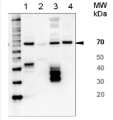Anti-HSP70/HSC70 | Heat shock protein 70/Heat shock cognate protein 70, Affinity purified
AS05 083A | Clonality: Polyclonal | Host: Rabbit | Reactivity: [global abtibody] for HSP70 and HSC70 in fish, mammals and fungi
Benefits of using this antibody
- Product Info
-
Immunogen: KLH-conjugated synthetic peptide conserved across all known sequences of HSP70 P08107 and HSC70 proteins P11142
Host: Rabbit Clonality: Polyclonal Purity: Immunogen affinity purified serum in PBS pH 7.4. Format: Lyophilized Quantity: 50 µg Reconstitution: For reconstitution add 50 µl of sterile water Storage: Store lyophilized/reconstituted at -20°C; once reconstituted make aliquots to avoid repeated freeze-thaw cycles. Please remember to spin the tubes briefly prior to opening them to avoid any losses that might occur from material adhering to the cap or sides of the tube. Tested applications: Immunoprecipitation (IP), Western blot (WB) Recommended dilution: 1 : 1000 (IP), 1 : 1000-1: 5000 (WB) Expected | apparent MW: 70 kDa
- Reactivity
-
Confirmed reactivity: Fish, mammals, fungi: Antrodia infirma, A. sinuosa, A. xantha, Gloeophyllum protractum, Gloeophyllum sepiarium, G. carbonarium, Junghunia luteoalba, Mustelus canis, Oligoporus sericiomollis, Phlebia cornea, Squalus acanthias, Zearaja maugeana Predicted reactivity: Bovine, Danio rerio (Zebrafish), Drosophila melanogaster, Hen, Mouse, Rat Not reactive in: No confirmed exceptions from predicted reactivity are currently known - Additional Information
-
Additional information: For detection of plant and algal cytoplasmic hsp70 we recommend following product: AS08 371
Additional information (application): This antibody is not suitable for work with samples from higher plants
- Background
-
Background: Heat shock protein 70 (Hsp70) is the major stress-inducible protein in vertebrates and is highly conserved throughout evolution. It plays a role as a molecular chaperone and is important for allowing cells to cope with acute stress or insult, especially those affecting the protein machinery. Heat shock cognate protein 70 (HSC70) is a highly conserved protein and a member of the family of molecular chaperones. Alternative names: HSP70.1, HSP70-1/HSP70-2, Heat shock 70 kDa protein 8
- Product Citations
-
Selected references: Bockus et al. (2020). Thermal Range and Physiological Tolerance Mechanisms in Two Shark Species from the Northwest Atlantic. The Biological Bulletin, ahead of print.
Morash et al. (2020). The endemic and endangered Maugean Skate (Zearaja maugeana) exhibits short-term severe hypoxia tolerance. Conserv Physiol. 2020 Jan 18;8(1):coz105. doi: 10.1093/conphys/coz105.
Tunnah et al (2016). Physiological responses to hypersalinity correspond to nursery ground usage in two inshore shark species (Mustelus antarcticus and Galeorhinus galeus). J Exp Biol. 2016 Jul 1;219(Pt 13):2028-38. doi: 10.1242/jeb.139964. Epub 2016 May 9.
Bockus (2016). A Study of the Regulatory and Environmental Factors Affecting Trimethylamine Oxide Accumulation in Marine Organisms. Open Access Dissertations. Paper 513.
French et al. (2015). High survivorship after catch-and-release fishing suggests physiological resilience in the endothermic shortfin mako shark (Isurus oxyrinchus). Conservation Physiology, Vol 3, Issue 1, 10.1093/conphys/cov044
- Protocols
- Antibody protocols
- Reviews:
-
This product doesn't have any reviews.
Accessories

AS05 083 | Clonality: Polyclonal | Host: Rabbit | Reactivity: [global abtibody] for HSP70 and HSC70 in fish, mammals and fungi
Benefits of using this antibody


